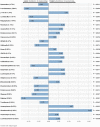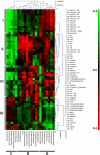Understanding host-microbiota interactions in the commercial piglet around weaning
- PMID: 34873196
- PMCID: PMC8648723
- DOI: 10.1038/s41598-021-02754-6
Understanding host-microbiota interactions in the commercial piglet around weaning
Abstract
Weaning is a critical period in the life of pigs with repercussions on their health and welfare and on the economy of the swine industry. This study aimed to assess the effect of the commercial early weaning on gut microbiota, intestinal gene expression and serum metabolomic response via an integrated-omic approach combining 16S rRNA gene sequencing, the OpenArray gene expression technology and 1H-NMR spectroscopy. Fourteen piglets from different litters were sampled for blood, jejunum tissue and caecal content two days before (- 2d), and three days after (+ 3d) weaning. A clearly differential ordination of caecal microbiota was observed. Higher abundances of Roseburia, Ruminococcus, Coprococcus, Dorea and Lachnospira genera in weaned piglets compared to prior to weaning showed the quick microbial changes of the piglets' gut microbiota. Downregulation of OCLN, CLDN4, MUC2, MUC13, SLC15A1 and SLC13A1 genes, also evidenced the negative impact of weaning on gut barrier and digestive functions. Metabolomic approach pinpointed significant decreases in choline, LDL, triglycerides, fatty acids, alanine and isoleucine and increases in 3-hydroxybutyrate after weaning. Moreover, the correlation between microbiota and metabolome datasets revealed the existence of metabolic clusters interrelated to different bacterial clusters. Our results demonstrate the impact of weaning stress on the piglet and give insights regarding the associations between gut microbiota and the animal gene activity and metabolic response.
© 2021. The Author(s).
Conflict of interest statement
The authors declare no competing interests.
Figures







Similar articles
-
Impact of Intestinal Microbiota on Growth Performance of Suckling and Weaned Piglets.Microbiol Spectr. 2023 Jun 15;11(3):e0374422. doi: 10.1128/spectrum.03744-22. Epub 2023 Apr 6. Microbiol Spectr. 2023. PMID: 37022154 Free PMC article.
-
Early socialization and environmental enrichment of lactating piglets affects the caecal microbiota and metabolomic response after weaning.Sci Rep. 2021 Mar 17;11(1):6113. doi: 10.1038/s41598-021-85460-7. Sci Rep. 2021. PMID: 33731752 Free PMC article.
-
Fecal microbiota transplantation modulates jejunal host-microbiota interface in weanling piglets.Microbiome. 2025 Feb 7;13(1):45. doi: 10.1186/s40168-025-02042-9. Microbiome. 2025. PMID: 39920804 Free PMC article.
-
Piglet gut microbial shifts early in life: causes and effects.J Anim Sci Biotechnol. 2019 Jan 14;10:1. doi: 10.1186/s40104-018-0308-3. eCollection 2019. J Anim Sci Biotechnol. 2019. PMID: 30651985 Free PMC article. Review.
-
Impact of Early Weaning on Development of the Swine Gut Microbiome.Microorganisms. 2023 Jul 5;11(7):1753. doi: 10.3390/microorganisms11071753. Microorganisms. 2023. PMID: 37512925 Free PMC article. Review.
Cited by
-
Supplemental Clostridium butyricum MIYAIRI 588 Affects Intestinal Bacterial Composition of Finishing Pigs.Microbes Environ. 2022;37(3):ME22011. doi: 10.1264/jsme2.ME22011. Microbes Environ. 2022. PMID: 36155363 Free PMC article.
-
Fecal microbiota transplantation in pigs: current status and future perspective.Anim Microbiome. 2025 Jul 20;7(1):76. doi: 10.1186/s42523-025-00440-w. Anim Microbiome. 2025. PMID: 40685369 Free PMC article. Review.
-
The Effects of Octapeptin Supplementation on Growth Performance, Serum Biochemistry, Serum Immunity, and Gut Microbiota in Weaned Piglets.Animals (Basel). 2024 Sep 2;14(17):2546. doi: 10.3390/ani14172546. Animals (Basel). 2024. PMID: 39272331 Free PMC article.
-
Effects of dietary cinnamaldehyde supplementation in the perinatal period on reproductive performance, milk composition, redox status and gut microbiota of sows.Anim Nutr. 2025 Mar 26;21:97-106. doi: 10.1016/j.aninu.2025.02.003. eCollection 2025 Jun. Anim Nutr. 2025. PMID: 40453238 Free PMC article.
-
Enhancing Weaned Piglet Health and Performance: The Role of Autolyzed Yeast (Saccharomyces cerevisiae) and β-Glucans as a Blood Plasma Alternative in Diets.Animals (Basel). 2024 Feb 16;14(4):631. doi: 10.3390/ani14040631. Animals (Basel). 2024. PMID: 38396599 Free PMC article.
References
-
- Kim JC, Hansen CF, Mullan BP, Pluske JR. Nutrition and pathology of weaner pigs: Nutritional strategies to support barrier function in the gastrointestinal tract. Anim. Feed Sci. Technol. 2012;173(1):3–16. doi: 10.1016/j.anifeedsci.2011.12.022. - DOI
-
- Lallès JP, Boudry G, Favier C, et al. Gut function and dysfunction in young pigs: Physiology. Anim. Res. 2004;53(4):301–316. doi: 10.1051/animres:2004018. - DOI
-
- Lallès JP, Bosi P, Smidt H, Stokes CR. Weaning—A challenge to gut physiologists. Livest. Sci. 2007;108(1):82–93. doi: 10.1016/j.livsci.2007.01.091. - DOI
-
- Pluske J, Hampson D, Williams I. Factors influencing the structure and function of the small intestine in the weaned pig: A review. Livest. Prod. Sci. 1997;51(1–3):215–236. doi: 10.1016/S0301-6226(97)00057-2. - DOI

